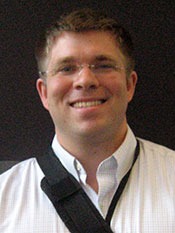Program Information
Concrete Forward-Scatter Fractions for Radiotherapy Shielding Applications
S Tanny*, E Parsai , University of Toledo Medical Center, Toledo, OH
Presentations
SU-E-T-90 Sunday 3:00PM - 6:00PM Room: Exhibit HallPurpose: There is little instruction within the primary shielding guidance document NCRP 151 for vault designs where the primary beam intercepts the maze. We have conducted a Monte-Carlo study to characterize forward-scattered radiation from concrete barriers with the intent of quantifying what amount of additional shielding outside the primary beam is needed in this situation.
Methods: We reproduced our vault in MCNP 5 and simulated spectra obtained from the literature and from our treatment planning system for 10 and 18 MV beams. Neutron and gamma-capture contributions were not simulated. Energy deposited was scored at isocenter in a water phantom, within various cells that comprised the maze, and within cells that comprised the vault door. Tracks were flagged that scattered from within the maze to the door and their contributions were tallied separately. Three different concrete mixtures found in the literature were simulated. An empirically derived analytic equation was used for comparison, utilizing patient scatter fractions to approximate the scatter from concrete.
Results: Our simulated data confirms that maze-scattered radiation is a significant contribution to total photon dose at the door. It contributes between 20-35% of the photon shielding workload. Forward-scatter fractions for concrete were somewhat dependent on concrete composition and the relative abundance of higher-Z elements. Scatter fractions were relatively insensitive to changes in the primary photon spectrum. Analytic results were of the same magnitude as simulated results.
Conclusions: Forward-scattered radiation from the maze barrier needs to be included in the photon workload for shielding calculations in non-standard vault designs. Scatter fractions will vary with concrete composition, but should be insensitive to spectral changes between machine manufacturers. Further plans for investigation include refined scatter fractions for various concrete compositions, scatter fraction measurement, and simulation of photo-nuclear interaction within the maze barrier for high-energy beams.
Contact Email:


